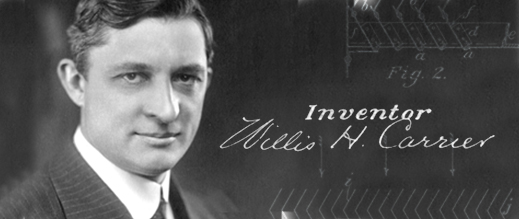
Willis Carrier
We celebrate Thomas Edison for the light bulb, the Wright Brothers for the airplane, Benjamin Franklin for electricity and this past July we celebrated Willis Carrier — inventor of the first modern electrical air conditioning unit? With this summer’s blazing heat, he might have to get his own holiday! Here’s a quick look at the history of this cool invention.
Evils of High Temps
In the 1840s, physician and inventor Dr. John Gorrie of Florida proposed the idea of cooling cities to relieve residents of “the evils of high temperatures.” He believed that cooling was the key to avoiding diseases such as malaria and making patients more comfortable, but his rudimentary system for cooling hospital rooms required ice to be shipped to Florida from frozen lakes and streams in the northern United States.
To get around this expensive logistical challenge, Gorrie began experimenting with the concept of artificial cooling. He designed a machine that created ice using a compressor powered by a horse, water, wind-driven sails or steam and was granted a patent for it in 1851. Although Gorrie was unsuccessful at bringing his patented technology to the marketplace — primarily due to the death of his chief financial backer — his invention laid the foundation for modern air conditioning and refrigeration.
July 17, 1902
Progress on this idea was frozen for several years until a new graduate from Cornell University, Willis Carrier, took a job at the Buffalo Forge Company in 1902.
Carrier was tasked with solving a humidity problem that was causing magazine pages to wrinkle at Sackett-Wilhelms Lithographing and Publishing Company in Brooklyn.
Through a series of experiments, Carrier designed a system that controlled humidity using cooling coils and secured a patent for his “Apparatus for Treating Air,” which could either humidify (by heating water) or dehumidify (by cooling water) air. As he continued testing and refining his technology, he also devised and patented an automatic control system for regulating the humidity and temperature of air in textile mills.
The first electrical air conditioner, designed and built by Carrier in Buffalo, began working on July 17, 1902!
It wasn’t long before Carrier realized that humidity control and air conditioning could benefit many other industries, and he eventually broke off from Buffalo Forge, forming Carrier Engineering Corporation with six other engineers.
Other fun Facts:
- In 1904, at the St. Louis World’s Fair, organizers used mechanical refrigeration to cool the Missouri State Building. The system used 35,000 cubic feet of air per minute to cool the 1,000-seat auditorium, the rotunda and other rooms within the Missouri State Building. It marked the first time the American public was exposed to the concept of comfort cooling.
- In 1906, Stuart W. Cramer of Charlotte was exploring ways to add moisture to the air in his textile mill. Cramer coined the term “air conditioning,” (as opposed to “air conditioner”) using it in a patent claim he filed that year as an analogue to “water conditioning”, then a well-known process for making textiles easier to process.
- Shortly thereafter, the first private home to have air conditioning was built in Minneapolis in 1914, owned by Charles Gates.
- In 1945, Robert Sherman of Lynn, Mass., invented a portable, in-window air conditioner that cooled, heated, humidified, dehumidified, and filtered the air.
- Engineer Henry Galson went on to develop a more compact, inexpensive version of the window air conditioner. By 1947, 43,000 of these systems were sold — and, for the first time, homeowners could enjoy air conditioning without having to make expensive upgrades.
- By the late 1960s, most new homes had central air conditioning, and window air conditioners were more affordable than ever.
- Air conditioning is now in nearly 100 million American homes, representing 87 percent of all households, according to the Energy Information Administration.




